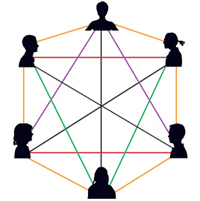
Inc.com | by Joel Spolsky | 2/1/2010
Have you ever invited employees to a meeting just so they wouldn’t feel left out? If so, you may be an overcommunicator.
When was the last time you scheduled a meeting and invited eight people instead of the three people who really needed to be there simply because you didn’t want anyone to feel left out?
When was the last time you sent a companywide e-mail that said something like, “Hey, attention coffee drinkers: If you finish the pot, make another!” even though there is actually only one person who violates this rule (and she’s your co-founder)?
When was the last time you got into a long discussion over the color palette for the new brochure with a programmer, who has nothing to do with the brochure but sure knows that he doesn’t like orange?
These are symptoms of a common illness: too much communication.
Now, we all know that communication is very important, and that many organizational problems are caused by a failure to communicate. Most people try to solve this problem by increasing the amount of communication: cc’ing everybody on an e-mail, having long meetings and inviting the whole staff, and asking for everyone’s two cents before implementing a decision.
But communications costs add up faster than you think, especially on larger teams. What used to work with three people in a garage all talking to one another about everything just doesn’t work when your head count reaches 10 or 20 people. Everybody who doesn’t need to be in that meeting is killing productivity. Everybody who doesn’t need to read that e-mail is distracted by it. At some point, overcommunicating just isn’t efficient.
It’s a particularly insidious problem for fast-growing start-ups. When you’re really small and you’re just starting out, you don’t have that many people, so keeping everyone in the loop on everything doesn’t really take that much time. But as you get bigger, the number of people who might potentially get involved in any particular discussion increases, and the amount of stuff you’re doing as a company increases, and the amount of time you can waste overcommunicating becomes a serious problem.
As companies expand, the people within them start to specialize. At such a point, some managers will conclude that they have a “keep everyone on the same page” problem. But often what they actually have is a “stop people from meddling when there are already enough smart people working on something” problem.
It’s not that Bob in Accounting doesn’t have anything useful to say about the photography for the new advertising campaign. Yes, Bob has a master’s in fine arts. Yes, Bob is an amateur photographer. And maybe he even has better taste than do the people in marketing. Still, Bob shouldn’t be telling the marketing manager what to do, because it’s just not efficient. In fact, it’s highly inefficient.
The cost of overcommunication within organizations was fleshed out by Fred Brooks in his 1975 book, The Mythical Man-Month. Brooks helped run the OS/360 project at IBM, building a giant operating system for the company’s mainframes. In those days, computers were large, room-size, water-cooled machines, sometimes with a massive 256,000 bytes of main memory. OS/360 was probably the largest software project ever attempted to that point. And it was monumentally late.
Every time some aspect of the project fell behind schedule, IBM assigned a few more people to the task. And what Brooks noticed, which still surprises people, is that this didn’t work. His observation came to be known as Brooks’ Law: Adding people to a late project tends to make it run later still.
Read that sentence again, because it’s not intuitive. Brooks discovered that adding people to a project will put it further behind schedule.
How can that be? Well, when you add a new person to a team, that person needs to communicate and coordinate with all the other people on the team. This doesn’t sound like a big deal, but it is. The new kid doesn’t know what’s going on, so somebody else on the team — somebody who just last week was doing productive work — has to stop his or her work and show this newbie the ropes.

Cross-functional or Dysfunctional? On every project, one person should be in charge of the flow of communication. You want the decision-making process to look like Figure A — not Figure B.
The bigger the team, the worse it gets. When you have a team of one person, you have no communication requirements. None.
Add a second person, and now you have a single connection: Adam and Mary have to talk to each other once in a while.
Now add a third person, say, Srinivas, and suddenly we’ve gone from one connection to three, since Srinivas has to talk to Adam and Mary.
Add a fourth person. I’m running out of names here to help me out — OK: Britney. If we add her, and she needs to coordinate with all of them, you get six connections.
For the mathematically inclined, the formula is that if you have n people on your team, there are (n2-n)/2 connections. This chart illustrates how this becomes a problem:
| People | Connections |
|---|---|
| 1 | 0 |
| 2 | 1 |
| 3 | 3 |
| 4 | 6 |
| 5 | 10 |
| 6 | 15 |
| 7 | 21 |
| 8 | 28 |
| 9 | 36 |
| 10 | 45 |
As you can see, the communications costs start to rise pretty rapidly until, on large teams, all anyone ever has time to do is to coordinate with everyone else — and no one gets any work done. In 2006, Moishe Lettvin, a former programmer at Microsoft, wrote a blog post describing the year he spent coordinating the list of items that would be featured on one menu in Windows Vista — the menu you use to turn off your computer. (See The Windows Shutdown Crapfest.) Lettvin figured that 43 people all had a voice in designing this one menu. Forty-three! By Brooks’s formula, that means managing 903 connections. Lettvin says he spent so much time on coordination tasks that, in 12 months, he produced fewer than 200 lines of code.
As the boss, you need to design ways to reduce communications paths. Eliminate companywide mailing lists — or at least charge $1.50 to post to them. Stop having large meetings. You need a culture in which people don’t get uptight because they weren’t included in a meeting, which means you need a culture that rewards people for doing their jobs and frowns on meddling in other people’s work.
And on every project, assign one person to make sure that communication happens — but only the right communication. Otherwise the team will just start having long meetings with everyone there and, frankly, people will socialize, and bloviate, and speechify, and argue about things they don’t really care about just to hear their own voices.
I think this is probably one of those cases in which the old, 1950s style of management accidentally got something right. In those General Motors–style companies, they at least had an idea for how information needed to move up and down neat, regimented org charts, which showed a modicum of recognition that the right answer is not that every single person in the organization needs to pay attention to everything.
When you started your company, you probably did a great job of communicating. Everybody told one another everything. And your customers loved it, because when they called in to ask about their purchase order, everybody knew where it was. But as you get bigger, you can’t keep telling everybody about every purchase order, so you have to invent specific communications systems so that exactly the right people find out and nobody else. Not because it’s confidential. Because it’s a waste of time.
. . . more
